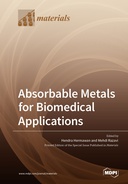Explore

Absorbable Metals for Biomedical Applications
0 Ungluers have
Faved this Work
Login to Fave
Absorbable metals have shown significant clinical potential for temporary implant applications, where the material is eventually replaced by healthy, functioning tissue. However, several challenges remain before these metals can be used in humans. Innovations and further improvements are required. This book collects scientific contributions dealing with the development of absorbable metals with improved and unique corrosion and mechanical properties for applications in highly loaded implants or cardiovascular and urethral stents.
This book is included in DOAB.
Why read this book? Have your say.
You must be logged in to comment.
Rights Information
Are you the author or publisher of this work? If so, you can claim it as yours by registering as an Unglue.it rights holder.Downloads
This work has been downloaded 79 times via unglue.it ebook links.
- 79 - pdf (CC BY) at Unglue.it.
Keywords
- absorbable
- absorbable implants
- absorbable metal
- alloy accumulation
- bioabsorbable metals
- bioactive resorbable plate
- Bioactivity
- bioceramics
- Biocompatibility
- biodegradable magnesium implants
- biodegradable material
- Biodegradation
- Biomaterials
- biomechanical loading evaluation
- bone surgery
- coating
- Corrosion
- corrosion behavior
- corrosion rate
- Cytotoxicity
- degradation
- degradation behavior
- electrochemistry
- Fracture Fixation
- friction stir processing
- hydrogen evolution
- in-vivo biocompatibility
- internal organs
- Iron
- iron foam
- magnesium
- magnesium (Mg)
- mandibular condylar fracture
- Mechanical properties
- mesenchymal stem cell
- Mg-alloys
- Mg-Zn-Sn alloy
- Microscopy
- Microstructure
- n/a
- oral and maxillofacial
- orthopedic
- orthopedic implant
- osteoconductivity
- osteoinductive activity
- poly-L-lactide
- polyethyleneimine (PEI)
- powder metallurgy
- rabbit coronary artery endothelial cells
- roughness
- sirolimus
- smooth muscle cells
- stent
- strontium
- surface treatments
- systemic reactions
- titanium (Ti)
- Toxicity
- uncalcined and unsintered hydroxyapatite
- unsintered hydroxyapatite/poly-l-lactide composite plate
- ureteral
- ureteral stent
- urothelial cells
- WE43/HA composite
- Zinc
- zinc alloy
Links
DOI: 10.3390/books978-3-0365-1763-6Editions

